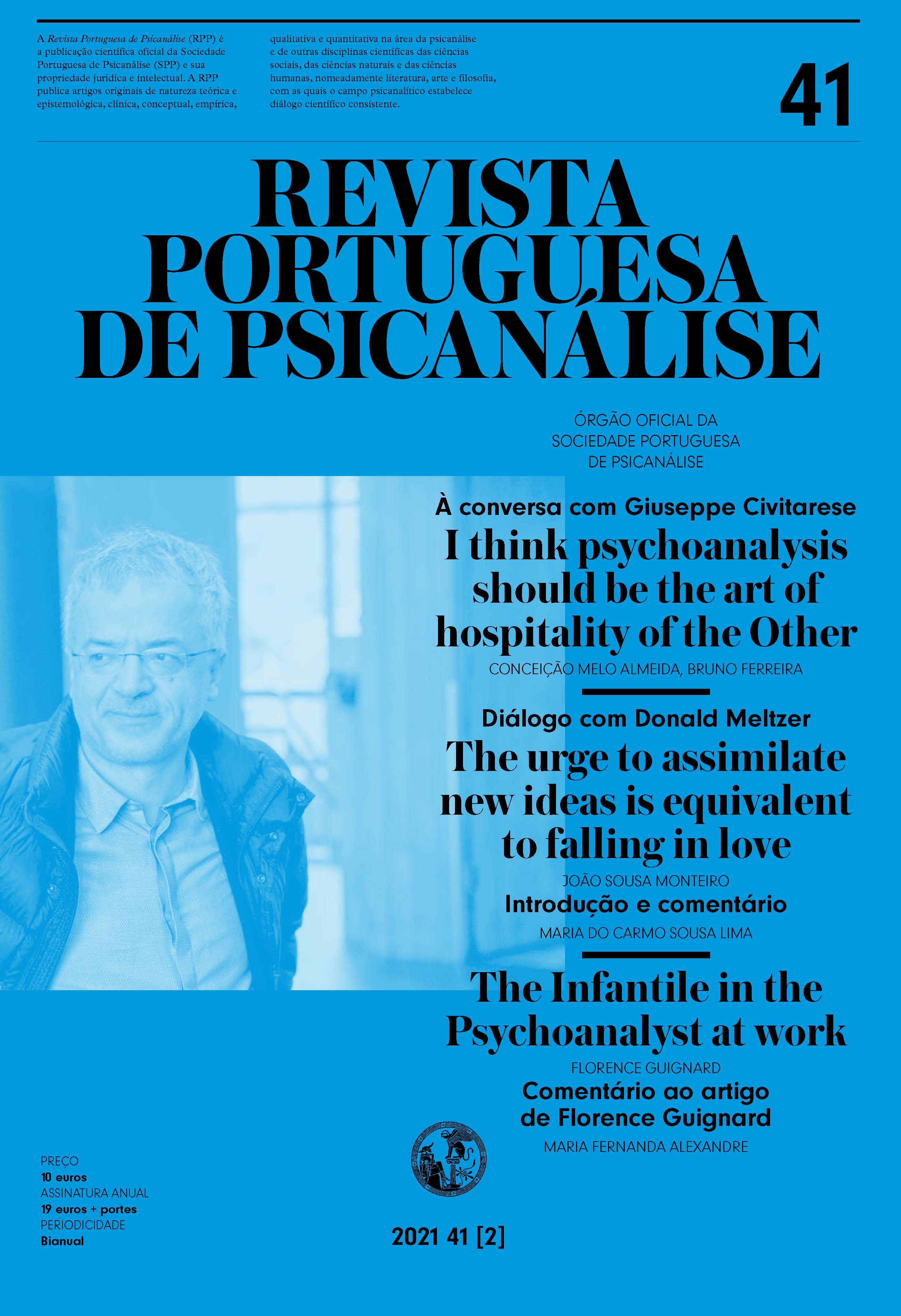ROSA DE JERICÓ E O ENVELOPE INSTITUCIONAL

Abstract
We will use the metaphor of the Rose of Jericho to intertwine two questions that the child whom we will call Rosa presented us with an unusual expressive and transformative capability. On the one hand, the capacity for psychic survival (resilience? - innate skills?) in the face of a traumatic environment of violence, abandonment, negligence, ruptures and discontinuities. On the other hand, the hypothesis that the countless institutions that welcomed this thread of discontinuity, functioned as a psychic skin (Bick, 1991), an institutional envelope (Houzel, 2010) and as "angels in the nursery" (Liberman, 2005), allowing Rosa to nourish herself enough to arrive without fracturing herself psychically until arrive to psychotherapy, also in an institution. It was finally this that allowed her to progressively reintegrate: to return to the desert, to cross it accompanied, to prepare for the search for a family land, where she can finally develop. We will try to illustrate the link between the construction of subjectivity, the role of assistance and care institutions and psychotherapeutic work in an institution.
Keywords
Abandonment, Child institutionalization, Resilience, Psychoanalysis, Institutional envelope
References
- Aberastury, A. (1982). Psicanálise da Criança: teoria e prática. Artes Médicas.
- Bick, E. (1991). A experiência da pele em relações de objeto arcaicas. Em E. B. Spillius, (Ed.), Melanie Klein hoje: desenvolvimentos da teoria e da técnica, vol 1: artigos predominantemente teóricos (pp.194–198). Imago. (Trabalho original publicado em 1968.)
- Bion, W. R. (2019). Seminário sobre Negative Capability. Sociedade Brita?nica de Psicanálise. Tradução do áudio: Alle Sturmer (2017). Em A. Chuster e A. Stu?rmer (Eds.), Capacidade Negativa: um caminho em busca de luz. Zagodoni. (Trabalho original de 1977.)
- Bion, W. (1988). Uma teoria sobre o processo de pensar. Em Estudos Psicanalíticos Revisados (Second Thoughts) (pp. 101–110). Imago. (Trabalho original publicado em 1967)
- Bion, W. R. (1991). Aprender com a experiência. Imago (Trabalho original publicado em 1962)
- Bion W. R. (1992). Cogitations. Karnac Books.
- Cassorla, R. M. S. (2016). O psicanalista, o teatro dos sonhos e a clínica do enactment. Blucher, Karnac Books.
- Cyrulnik, B. (2003). Resiliência: essa inaudita capacidade de construção humana. Instituto Piaget.
- Dias, C. A. & Monteiro, J. S. (1989): Eu já posso imaginar que faço. Assírio & Alvim.
- Doron, J. (2013). Du Moi-peau à l'enveloppe psychique. Em D. Anzieu et al. (Eds.), Les enveloppes psychiques (3.ª ed, pp.1–17). Dunod.
- Faimberg, H. (2005). The telescoping of generations: listening to the narcissistic links between generations. Routledge.
- Ferreira, T. (2002). Em defesa da criança: teoria e prática psicanalítica da infa?ncia. Assírio & Alvim.
- Fialho, O. (2019). Desenho infantil ? espelho do mundo interno da criança. Colibri.
- Fraiberg, S., Adelson, E., Shapiro, V. (1991). Ghosts in the nursery: a Psychoanalytic approach to the problems of impaired infant-mother relationships. Journal of American academy of child psychiatry, 14(3): 387–421.
- Freud, A. (1936). The ego and the mechanisms of defense. International Universities Press.
- Freud, S. (1969a). O Ego e o Id. Em Edição standard brasileira das obras psicológicas de Sigmund Freud. vol. XIX (pp. 15–80). Imago. (Trabalho original publicado em 1923.)
- Freud, S. (1969b). Construções em Análise. Em Edição standard brasileira das obras psicológicas de Sigmund Freud. vol. XXIII (pp.165–174). Imago. (Trabalho original publicado em 1937.)
- Hinshelwood, R. D. (2003): O que acontece nos grupos: Psicanálise, o indivíduo e a comunidade. Via Lettera.
- Houzel, D. (2010). Le concept d’enveloppe psychique. In Press.
- Klein, Melanie. (1923). The development of a child. International Journal of Psychoanalysis, 4, 419–474.
- Lieberman, A., Padrón, E., Van Horn, P., Harris, W. (2005). Angels in the nursery: the intergenerational transmission of benevolent parental influences. Infant Mental Health Journal, 26(6), 504–520.
- Mahler, M. (1982). O processo de separação-individuação. Artes Médicas. (Obra original em Inglês publicada em 1979.)
- Melícias, A. B. (2019a). Comporta-da-mente: do observável ao sentido. Conferência apresentada nas II Jornadas da Unidade de Psicologia Clínica do Centro Universitário de Coimbra, no dia 22.03.2019. Não publicada.
- Melícias, A. B. (2019b). Narrativas figuradas: el dibujo en el psicoanálisis con nin?os. Revista de Psicoanálisis de la Asociación Psicoanalítica de Madrid, 34(87), 927–960.
- Meltzer D. & Harris, M. (1976). A psychoanalytic model of the child-in-the-family-in-the-community. Em A. Hahn (Ed.), Sincerity: collected papers (pp. 387–454). Karnac Books.
- Pérez-Sánchez, A. (1996). Práticas psicoterapéuticas, psicoanálisis aplicado a la asistencia pública. Fundación Vidal i BarraqueRosa
- Spitz, R.A. (1945). Hospitalism An Inquiry into the Genesis of Psychiatric Conditions in Early Childhood. Psychoanalytic Study of the Child, 1, 53–74.
- Stern, D. N. (1998). The interpersonal world of the infant. Karnac Books.
- Stern, D. N. (2006). O momento presente na psicoterapia e na vida de todos os dias. Climepsi.
- Winnicott, D. W. (1953): Transitional objects and transitional phenomena. International Journal of Psycho-Analysis, 34(2), 89–97.
- Winnicott, D. W. (1990). O ambiente e os processos de maturação: estudos sobre a teoria do desenvolvimento emocional. Artes Médicas. (Trabalho original publicado em 1965.)